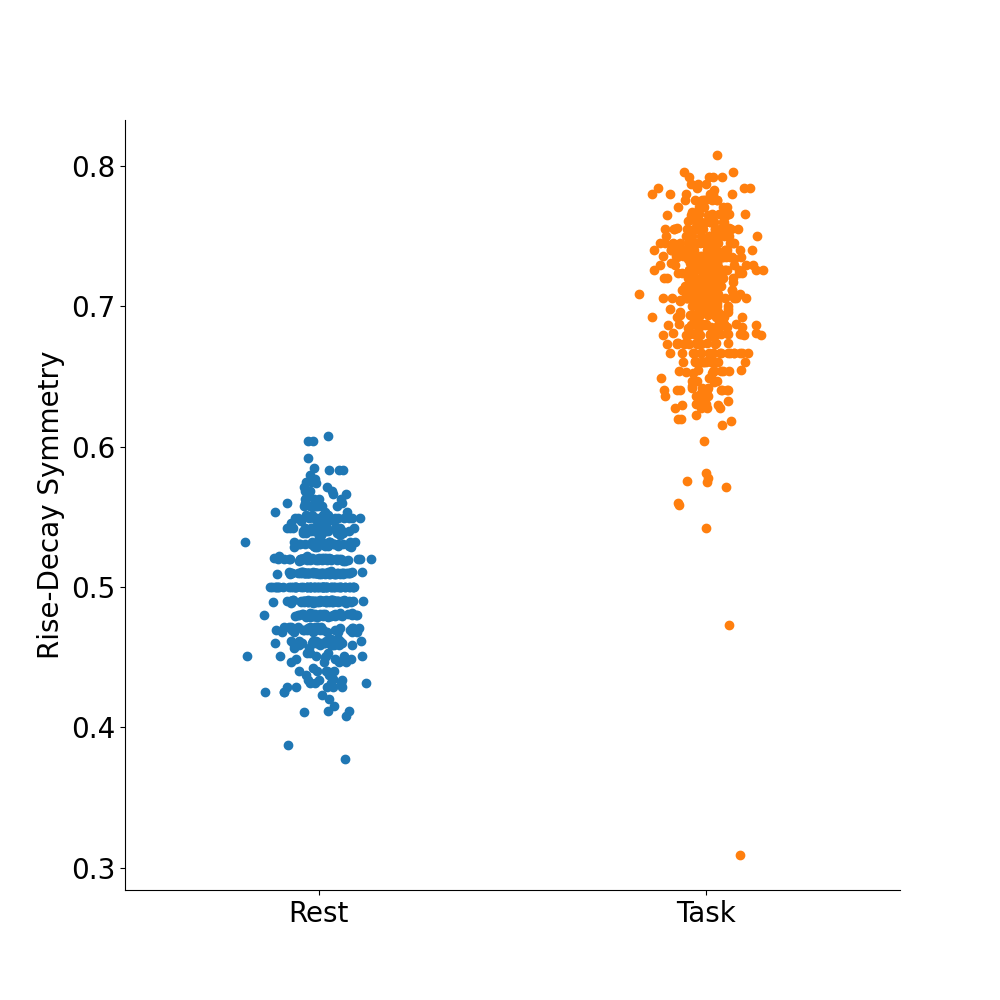Note
Go to the end to download the full example code.
4. Running Bycycle on 2D Arrays¶
Compute bycycle features for 2D organizations of timeseries.
Bycycle supports computing the features of 2D signals using BycycleGroup.
Signals may be organized in a different ways, including (n_epochs, n_timepoints) or
(n_channels, n_timepoints). The difference between these organizataions is that continuity is
preserved across epochs, but not across channels. The axis argument is used to specificy either
continuous (axis=None) and non-continuous (axis=0) recordings.
import numpy as np
import pandas as pd
import matplotlib.pyplot as plt
from neurodsp.sim import sim_combined
from bycycle import BycycleGroup
from bycycle.utils import flatten_dfs
from bycycle.plts import plot_feature_categorical
Example 1. The axis Argument¶
Here, we will show how the axis arguments works. The axis argument be may specified as:
axis=0: Iterates over each row/signal in an array independently (i.e. for each channel in (n_channels, n_timepoints)).axis=None: Flattens rows/signals prior to computing features (i.e. across flatten epochs in (n_epochs, n_timepoints)).
arr = np.ones((3, 4))
dim0_len = np.shape(arr)[0]
print("axis=0")
for dim0 in range(dim0_len):
print(np.shape(arr[dim0]))
print("\naxis=None")
print(np.shape(arr.flatten()))
axis=0
(4,)
(4,)
(4,)
axis=None
(12,)
Example 2. 2D Array (n_epochs, n_timepoints)¶
The features for a 2d array with a (n_epochs, n_timepoints) organization will be computed here.
This is an example of when using axis = None is appropriate, assuming each epoch was recorded
continuously. Data will be simulated to produce to rest and task epochs with varying rise-decay
symmetries.
# Simulation settings
n_seconds = 10
fs = 500
freq = 10
f_range = (5, 15)
n_epochs = 10
# Define rdsym values for rest and task trials
rdsym_rest = 0.5
rdsym_task = 0.75
# Simulate timeseries
sigs_rest = np.zeros((n_epochs, n_seconds*fs))
sigs_task = np.zeros((n_epochs, n_seconds*fs))
# Rest epoch
sim_components_rest = {'sim_powerlaw': dict(exponent=-2),
'sim_bursty_oscillation': dict(freq=10, cycle='asine',
enter_burst=0.75, rdsym=rdsym_rest)}
# Task epoch
sim_components_task = {'sim_powerlaw': dict(exponent=-2),
'sim_bursty_oscillation': dict(freq=10, cycle='asine',
enter_burst=0.75, rdsym=rdsym_task)}
for ep_idx in range(n_epochs):
sigs_rest[ep_idx] = sim_combined(n_seconds, fs, components=sim_components_rest)
sigs_task[ep_idx] = sim_combined(n_seconds, fs, components=sim_components_task)
# Compute features with default bycycle thresholds
thresholds = {
'amp_fraction':0.,
'amp_consistency': .5,
'period_consistency': .5,
'monotonicity': .8,
'min_n_cycles': 3
}
bg_task = BycycleGroup(thresholds=thresholds)
bg_task.fit(sigs_task, fs, f_range, axis=None)
bg_rest = BycycleGroup(thresholds=thresholds)
bg_rest.fit(sigs_rest, fs, f_range, axis=None)
# Merge into a single dataframe
df_task = flatten_dfs(bg_task.df_features, ['task'] * len(bg_task), 'Epoch')
df_rest = flatten_dfs(bg_rest.df_features, ['rest'] * len(bg_rest), 'Epoch')
# Limit to bursting cycles
df_task_bursts = df_task[df_task['is_burst'] == True]
df_rest_bursts = df_rest[df_rest['is_burst'] == True]
df_bursts = pd.concat([df_task_bursts, df_rest_bursts], axis=0)
# Plot
plot_feature_categorical(df_bursts, 'time_rdsym', group_by='Epoch', ylabel='Rise-Decay Symmetry',
xlabel=['Rest', 'Task'])

Total running time of the script: (0 minutes 0.202 seconds)